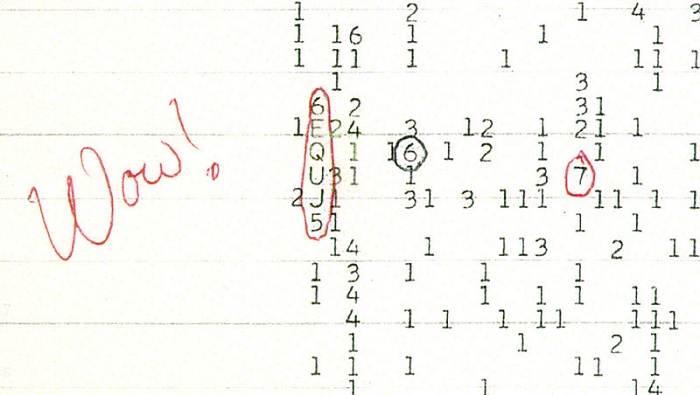.
Are You There, E.T.? SETI Finds No Alien Signals from Exoplanets
.

A scan of a color copy of the original computer printout bearing the Wow! signal, taken several years after the signal's 1977 arrival.
CREDIT: The Ohio State University Radio Observatory and the North American AstroPhysical Observatory (NAAPO)
.
Just in case any aliens out there in the universe are listening, more than 10,000 Twitter messages, plus videos from celebrities such as comedian Stephen Colbert, have been beamed into space as a big "Hello!" from Earth.
The messages are intended as a response to what's called the Wow! signal, an intriguing radio signal detected on Aug. 15, 1977 that some thought was a call from extraterrestrials. The 72-second transmission was picked up by the Big Ear radio observatory at Ohio State University, coming from the direction of the constellation Sagittarius.
Because the radio signal was 30 times more powerful than the average radiation from deep space, a volunteer astronomer named Jerry Ehman who was watching the telescope data scrawled "Wow!" on a computer printout, leading to the signal's moniker. No evidence ever arrived actually linking the transmission to an alien civilization, and no repeat message from the same direction has ever been detected, and the Wow! Signal remains a mystery.
-
Intelligent alien life is likely relatively rare throughout our Milky Way galaxy, with fewer than one in a million solar systems harboring civilizations advanced enough to send out radio signals, a new study reports.
A research team that includes famed alien hunter Jill Tarter — the model for astronomer Ellie Arroway in Carl Sagan's famous book "Contact" — surveyed dozens of planet-hosting stars for radio signals from alien civilizations. They turned up nothing.
"No signals of extraterrestrial origin were found," the researchers conclude in the study, which has been accepted for publication in The Astrophysical Journal.
Quelle: SPACE.COM
